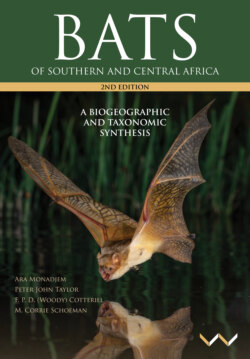Читать книгу Bats of Southern and Central Africa - Ara Monadjem - Страница 50
На сайте Литреса книга снята с продажи.
SPECTROGRAMS AND ECHOLOCATION
ОглавлениеIn this book, three criteria were applied to graphically represent the echolocation call of bat species on spectrograms using BatSound Pro software (version 3.20; Pettersson Elektronik AB, Uppsala, Sweden). First, only signals with a high signal-to-noise ratio were considered, that is, the signal from the bat was at least three times stronger than the background noise as displayed on the time-amplitude window. Second, only signals that were not saturated were analysed (Fenton et al. 2001). Finally, for most low duty-cycle bats only search-phase signals that were recorded at least three seconds after releasing the bat were considered (O’Farrell and Gannon 1999). Echolocation calls of high duty-cycle bats were recorded with the bat in the hand to eliminate any possible Doppler-shift or compensation for it by the bat when in flight (Heller and von Helversen 1989).
Duration, bandwidth and peak echolocation frequency are reported as indicators of sensory ability of low duty-cycle echolocating bats (Figure 39). Only duration and peak echolocation frequency are reported as indicators of sensory ability of high duty-cycle echolocating bats because the bandwidths of their CF calls are similarly narrow.
Figure 39. A graphical representation of echolocation parameters. Note that these parameters were not measured from the spectrogram: peak frequency and bandwidth were measured from the power spectrum, while duration was measured from the oscillogram (not shown).
Where possible, genetic analyses confirmed species identification of the bats that were recorded for this book (e.g. Eick et al. 2005, Schoeman 2006, Stoffberg 2007, Stoffberg et al. 2012, Taylor et al. 2012, 2018a).
